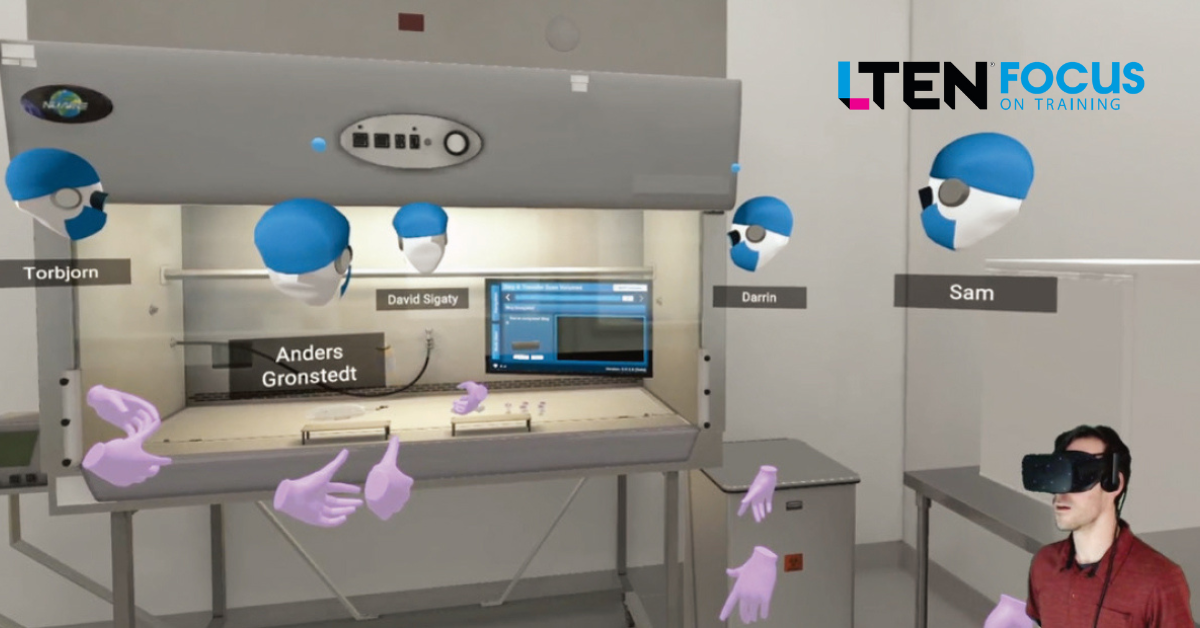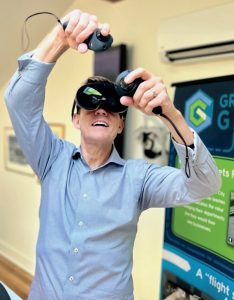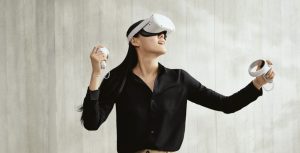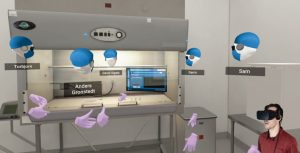
Takeda, Novartis and BMS are turning to VR simulations
Technology – By Anders Gronstedt, Ph.D
 Cell and gene therapies, which hold great promise for the treatment of diseases like cancer and diabetes, are the next wave of life sciences innovation. Manufacturing these highly customized therapies is a labor-intensive process that requires an extremely high level of learning innovation.
Cell and gene therapies, which hold great promise for the treatment of diseases like cancer and diabetes, are the next wave of life sciences innovation. Manufacturing these highly customized therapies is a labor-intensive process that requires an extremely high level of learning innovation.
With more lab technicians to train than instructors and training labs available, cell and gene therapy leaders Takeda, Novartis and Bristol Myers Squibb are turning to virtual reality (VR) simulations. Recruits practice crucial lifesaving skills in failsafe, real-time rendered cleanrooms deployed on reality-bending high-quality headsets that cost less than an airline flight.
“We use VR simulators to train cleanroom technicians on aseptic processes, equipment operation and laboratory manipulations,” said Brian Kesselmeyer, associate technical director and Cell Therapy Capability Center lead at Bristol Myers Squibb. “It’s ushering in a new era of experiential learning that promises to upend recruitment, selection and training in life sciences as we know it.”
Unlike traditional pharma manufacturing (pills, infusions), cell and gene therapies are made to order. Patient cells or genes must be painstakingly purified and modified for weeks in labs before being injected back into the patient. Mistakes have life-and-death consequences, and every worker is shadowed by a quality reviewer.
As much as 25% of CAR T-cell therapy expense is driven by labor. Training operators to make these personalized medicines dependably, without taking physical lab space or subject matter experts away from production, is a billion-dollar challenge.
One solution: What if we could re-create physical cleanrooms with interactive, photo-realistic digital versions?
 BMS Cell Therapy VR Cleanroom
BMS Cell Therapy VR Cleanroom
Bristol Myers Squibb cell therapy lab techs, working from literally anywhere in the world, don a VR headset and dive into an immersive, high-fidelity cleanroom of such convincing verisimilitude that they feel like they’re actually there.
“They can practice gowning and gloving, sterile tube welding and sealing, first air rule and aseptic practices in a virtual lab,” said Elissa Hoehn, consultant for the Cell Therapy Capability Center at Bristol Myers Squibb. “Moving seamlessly from the real to the digital realms, they can build muscle memory before they even put afoot in the training lab.”
The simulation starts in the learning level, which is built on step-by-step video tutorials, feedback and guided practice. Next, students move on to the practice level, which mimics the real-life working experience (i.e., no handholding). Techs can rehearse techniques over and over to hone skills in preparation for their manufacturing qualification in a physical training lab.
VR simulations build mastery by offering deliberate practice at the edge of users’ comfort zones. When they get it wrong, the sim resets so they can try that step again. There are unlimited re-dos in the metaverse.
VR training saves not only trainer and lab time, but also slashes the use of consumables (gowning and personal protective equipment, plastic bags and tubing, media and chemicals) that would otherwise end up in landfills or burned as biohazardous waste.
Takeda’s Multi-User Simulation
Takeda is piloting a shared virtual cell therapy manufacturing facility for up to eight students and instructors (again, sited anywhere in the world). They can interact seamlessly, talk to one another and learn with and from one another in the performance environment.
“Multi-user VR simulations elevate the learning experience by providing the sensation of working shoulder-to-shoulder with colleagues, just like in real life,” said Ted Lehman, associate director of Takeda Cell Therapy. “Students can conduct collaborative tasks, handing each other equipment and inspecting one another’s work, for instance. Succeeding and failing together, the members of the cohort learn with and from one another in the performance environment and build trust.”
 Novartis VR Pioneer
Novartis VR Pioneer
Novartis pioneered virtual reality training for its CAR T-cell therapy manufacturing five years ago.
“The sensory experiences of touch, vision and sound are incredibly convincing,” said Steve Sitek, head of talent, organizational development, inclusion, learning at Novartis Gene Therapies. “For instance, when users spray their hands with an antiseptic cleaner, both hands feel a slight vibration through the hand controllers and they hear the spray bottle in the headset. The brain suspends disbelief and generates a sense that their hands are actually being sprayed.”
Hand and body tracking in the sims measures if the students’ hands are angled correctly so as to not interrupt airflow in the biosafety cabinet.
It would make Aristotle proud. Educational theorists as far back as the ancient Greek philosopher have pointed out that we cannot learn what we have not experienced. This is a critical time to reimagine life sciences training around an assumption of constructivist and visceral learning we once could only dream about.
Today, Novartis is even developing VR to train manufacturing personnel of another innovative cancer treatment: radiopharmaceutical therapies. Operators practice working in glove boxes with radioactive medication in a safe virtual environment, just like pilots practice flying in a flight simulator.
A VR Learning Partner
Developing these 3D immersive simulations is a complex and iterative process that marries the artistry and tech wizardry of virtual reality and game development with learning design and subject matter expertise.
A strategic VR partner can help identify high-value opportunities, build the business case, overcome obstacles, bring your concepts to (virtual) reality and scale them across the enterprise with single sign-on and student learning management system reporting.
BMS, Takeda and Novartis worked with Gronstedt Group to bring their learning visions into the metaverse.
Regulatory Pressure
A third of all therapies are soon expected to be cell- and gene-based. Under pressure from regulators to prove that the products given to patients are the same as the ones tested in clinical trials, the industry needs to invest in completely new manufacturing training models.
Traditional new drug reviews focused 80% on clinical and 20% on manufacturing controls, but that proportion is now inverted. Developers must prove that they’re effectively training staff to consistently manufacture these highly customized therapies. Ultra-realistic VR cleanroom simulators are the learning breakthrough that will bring the medical innovations of cell and gene therapies to market.
The metaverse is here – it’s just unevenly distributed. Where cell and gene therapies are leading the way, the entire life sciences industry will follow.
Regardless of your field of work, consider how to reduce training costs, improve job performance and boost engagement with a VR “flight simulator” of life sciences learning.
 Anders Gronstedt, Ph.D., anders@gronstedtgroup.com, is president of the Gronstedt Group.
Anders Gronstedt, Ph.D., anders@gronstedtgroup.com, is president of the Gronstedt Group.








